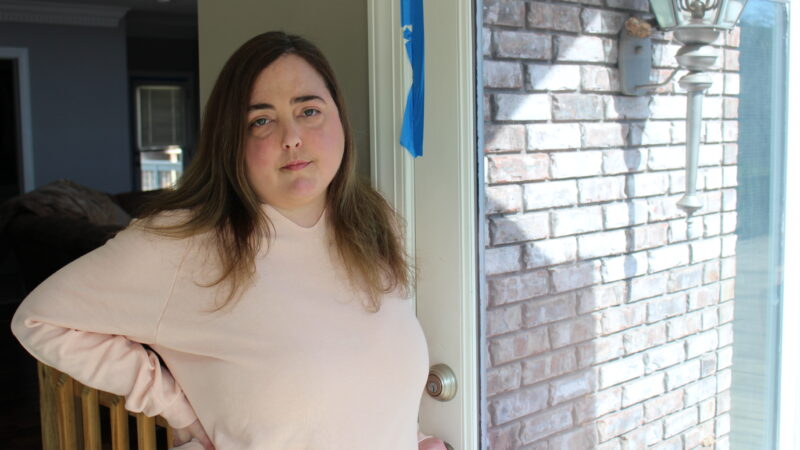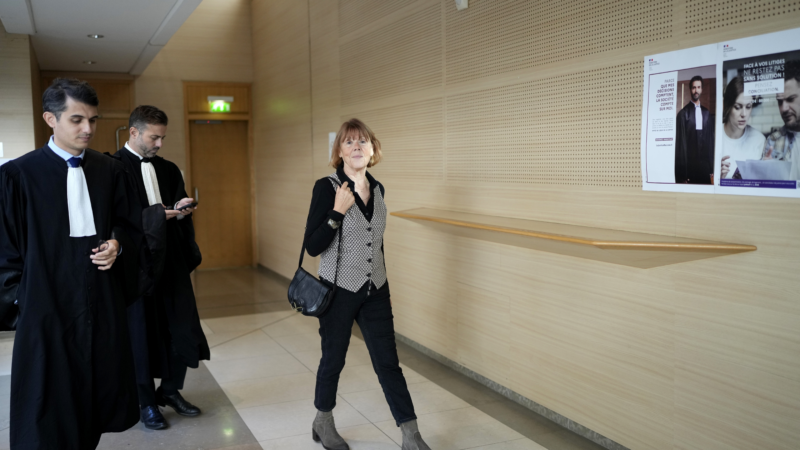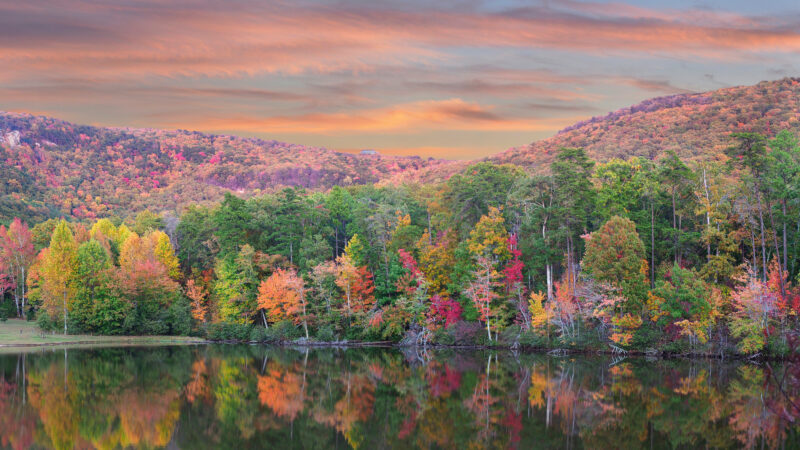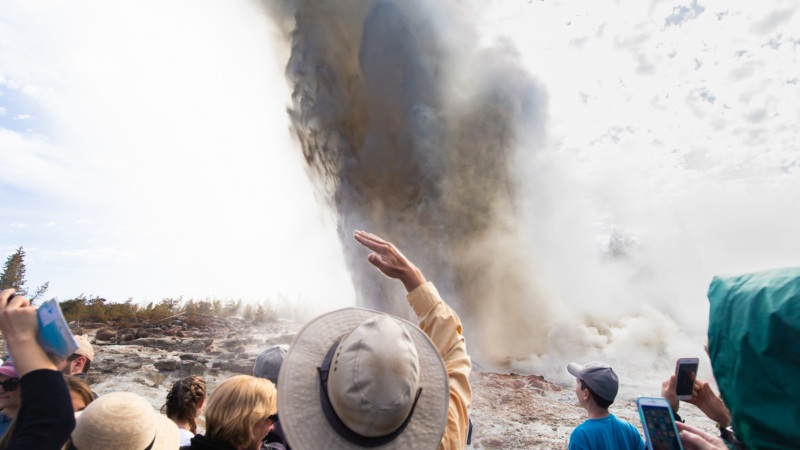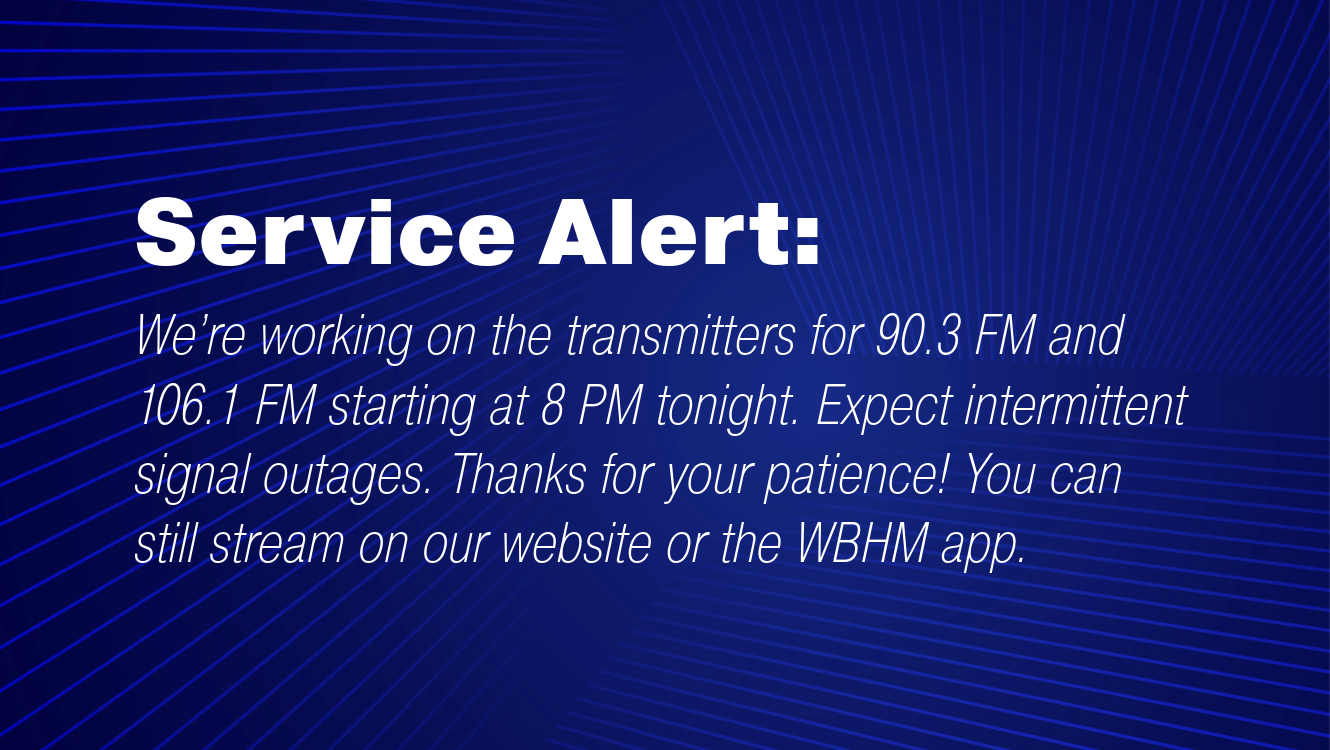A months-long landfill fire in Alabama reveals waste regulation gaps
Krissy Harmon's home is less than a mile from a landfill that caught fire more than three months ago. She uses blue painter's tape to keep smoke out and says her family still experiences health issues brought on by the fire.
Additional reporting by Mary Scott Hodgin
The smell started seeping into Krissy Harmon’s home late at night the weekend after Thanksgiving.
“I actually thought the house was on fire,” Harmon recalled.
The acrid burning smell wasn’t coming from Harmon’s home. A nearby landfill in St. Clair County, Ala., had just ignited — and it wouldn’t stop burning for months.
The landfill, which makes up more than 13 acres, initially sent flames above the tree line and blanketed the area in smoke. Daniel Cash, who lives down the street from the landfill, said the smoke and flames had spread so high that a colorful haze filled the sky.
“It looked like a sunset from the colors of the fire and the smoke in the air and the vast area of it,” Cash recalled as he prepared for his shift at the nearby Waffle House.
For almost two months after that night, homes near the landfill were inundated with smoke and fumes. Some days, depending on the wind’s direction, people 20 miles away in Birmingham reported smelling the emissions.
It’s not known how the fire started at the privately owned landfill, which operates under the name Environmental Landfill Inc. Early on, local firefighters and the Alabama Forestry Commission tried to squelch the flames, but they were unsuccessful because the fire was largely underground.
Smoke billowed out of the mounds of buried waste for weeks as state and local authorities struggled to figure out who had jurisdiction to put out the fire, eventually calling on the Environmental Protection Agency. Now neighbors and local climate advocates are left asking why the site was never regulated, if the fire could have been prevented and how to keep a similar disaster from happening again. These concerns led state and local leaders to form a working group this month to assess their response.
The EPA says it doesn’t track landfill fires, but according to the U.S. Fire Administration, this is just one of the tens of thousands of landfill fires, compacted-trash fires and dumpster fires that happen every year around the United States.
An unregulated hazard
Environmental Landfill was supposed to take in only downed trees, stumps and other natural materials — what’s known as vegetative waste. But a decade’s worth of records from the Alabama Department of Environmental Management (ADEM) shows the business took other trash, including treated power poles, scrap metal, tires, appliances and other waste that should have been regulated. Some of that trash was buried among the vegetative waste when the fire started. During many of the agency’s visits, inspectors noted that the site was a fire hazard. The landfill’s operator declined to comment for this story.
ADEM maintains that the fire is primarily fueled by wood and other natural debris. Neighbors, however, say they’ve smelled fumes they know aren’t from trees and tree limbs.
Frank Read stayed in his home across from the landfill and spent hundreds of dollars on air purifiers and filters to mitigate the fumes. He said he could smell the different types of materials as they smoldered.
“It depends on what’s burning at the time,” Read said. “There’s times where it smells straight like wood, and then there’s other times where you know tires are burning. You can smell the rubber. And then there’s times when there’s like a chemical smell. … And that’s what’s scary.”
Other than leaving home to go to his job at a tank-cleaning business, Read said it was impossible to spend time outdoors.
“You couldn’t be outside for 15 minutes without being choked out,” Read said.

Some people in the small community near the site fled their homes, staying in hotels or rental properties miles away. Krissy Harmon, however, couldn’t leave.
“We have a disabled child. We can’t really take him just anywhere,” said Harmon, who founded a nonprofit focused on serving people with autism.
Harmon’s family spent insurance money on air purifiers and scrubbers, and they have lined their windows and doors with blue painter’s tape, but they have still suffered health effects.
Harmon’s 13-year-old son, who has severe autism and a rare genetic disorder, can’t communicate if he’s experiencing symptoms of smoke inhalation. That adds to Harmon’s stress.
Harmon, who is immunocompromised, said she has had trouble sleeping, along with experiencing headaches, nosebleeds and other painful symptoms.
“It makes me feel like my throat is on fire at times. Like if you’ve ever had strep, and it feels like razor blades cutting,” she said.
Read and Cash have had similar symptoms, including coughing, chest pains and dizziness.
In a late December news release, ADEM advised residents to stay inside and talk to their doctor if they were experiencing health issues because of the smoke.
People in the affected communities asked local politicians for help for weeks, but their pleas went unanswered as county and state officials went back and forth about who had the authority — and the funds — to put out the fire.
From the beginning, ADEM continued to remind people that it doesn’t fight fires; nor does it have any regulatory responsibility over vegetative waste. The agency eventually said the St. Clair County Commission would need to put out the fire, but officials with the county said they didn’t have the authority to enter the private property. It wasn’t until Gov. Kay Ivey declared a state of emergency — the same day the EPA stepped in — that the county could use public funds on the property.
Lance LeFleur, ADEM’s director, said the weekslong delay was impossible to sidestep.
“It’s taken longer than anybody would have liked for it to take, but we had to go through the process of the state and local community examining and exhausting all of its options before bringing EPA in,” he said.
Read said he and his neighbors were frustrated about the lack of response.
“The fire starts Sunday. I didn’t expect it to be out by Tuesday. I don’t think any resident did,” Read said. “What frustrated us is that it took them five weeks to decide who was going to be in charge of it. That’s the dumbest thing I’ve ever heard of.”
On Jan. 4, more than a month after the fire started, ADEM asked the EPA to sample air at the site. The results showed synthetic compounds like trichloroethylene and Freon in the smoke, as well as high levels of cancer-causing chemicals such as benzene at homes near the landfill.
The heightened levels of some chemicals authorized the EPA to respond in mid-January. The landfill has been on fire for more than three months.

Photo by Zoe McDonald
The regulatory gap
ADEM, the Alabama agency that regulates the state’s landfills, doesn’t consider environmental waste to be solid waste, and neither does the EPA.
“Federal regulation is all pretty much targeted on landfills that handle toxic chemicals,” said Robert Percival, a professor of environmental law at the University of Maryland’s Carey School of Law and co-author of the casebook Environmental Regulation: Law, Science, and Policy.
Materials like yard waste or storm debris are low on regulators’ list of priorities because of this.
Most regulated landfills have a system to prevent fires, such as applying a thick layer of dirt on top of each day’s waste. Some landfills monitor internal heat and gas levels to predict and prevent fires. Unregulated landfills don’t take the same measures.
“For municipal landfills, usually there is a collection system. There’s a gas well, there are monitoring systems in place … that you could [use to] understand the issue and avoid disasters like this,” said Rouzbeh Nazari, a professor at the University of Alabama at Birmingham’s civil engineering department and School of Public Health, as well as the director of the university’s Sustainable Smart Cities Research Center. “But in the case of green waste, you don’t have any of those.”
Even if a landfill containing only green waste catches on fire, the smoke can still lead to adverse health effects, said Jeff Wickliffe, an environmental health sciences professor at the University of Alabama at Birmingham.
“When you look at what’s coming out of the landfill based on the EPA measurements, those are by and large still derived from the biomass that’s there,” Wickliffe said. “They’re still hazardous chemicals. And so I think we need to realize that whatever the source is, that landfill’s still producing potential hazards.”
The state’s lack of regulations around vegetative waste is why Environmental Landfill continued its operations for so long.
It’s also why officials and agencies are left unsure about who has the authority to handle fires at these types of sites when local firefighters aren’t equipped to put them out.
A lack of prevention
Green waste isn’t regulated in many states across the country, so operators of these landfills aren’t pressured to take fire prevention measures.
According to Nazari, landfill owners and operators don’t receive enough science-backed information or support to prevent potential disasters.
Operators of environmental waste sites need to understand how yard debris such as trees and leaves decompose, generating heat.
Think of a vegetative waste landfill like one massive compost pile. The sheer volume of matter coupled with increasing heat and gas can be the catalyst for an underground fire that can last for months or longer.
“If you’re just piling up all the green waste, is that a safe method? And the answer is no,” Nazari said. “It has to be properly capped layer by layer and mixed with enough soil to reduce the chance of that decomposition.”
Nazari said the fire risk increases if other waste gets mixed in, like in the case of Environmental Landfill.
As the U.S. population grows, so will the need for more landfills. More landfills mean a greater risk for fires. The only way to prevent fires, Nazari said, is if landfills are managed better in the future — whether that’s through increased regulations or better communication among scientists, regulators and landfill owners.

After the smoke clears
The EPA is finishing its work at the Environmental Landfill site, where it has reduced the smoke by applying a thick layer of dirt to the landfill’s surface. Some areas still continue to burn, but the EPA plans to have the fire extinguished by the end of March.
Neighbors say the air is getting easier to breathe, but they worry about the damage to their homes and the future health impacts from inhaling smoke and chemical fumes for months.
They are also left wondering why a site that state regulators knew presented a fire risk continued to operate for so long. They hope the state will enact changes to prevent future landfill fires, including more regulations on landfills that take vegetative waste.
“If we’re going to have a government agency that regulates landfills, then they probably should regulate landfills,” Harmon said.
Percival said it’s not uncommon for a disaster to precede a change in law.
“It’s kind of the story of environmental law. Generally, we react when there’s a problem. … Politicians and regulators act when there is a crisis that brings it to their attention,” he said.
In the wake of a long-burning mulch pile fire in Texas, for example, then-Gov. Rick Perry in 2007 signed into law restrictions on the size of mulch piles and gave Texas’ environmental agency authority to respond to similar fires.
LeFleur said it’s up to Alabama legislators to change the laws concerning vegetative waste. But he acknowledged that ADEM is looking at other options, like keeping a contractor on retainer to fight these types of fires or allocating funds that can be used for unprecedented events.
“We are working with the county, elected officials, with our sister agencies around the state — we’ll be working with the legislature also — to determine what can be done to fill this gap that evidently has occurred because of this issue,” LeFleur said.
At the beginning of March, ADEM officials announced a working group consisting of local lawmakers and officials from agencies including the Alabama Forestry Commission and the state’s Emergency Management Agency. The group will be tasked with making recommendations to state leaders and lawmakers about how state and local governments can be better prepared to respond if a similar event happens in the future.
Though the EPA doesn’t require states to regulate environmental waste, Percival said state officials are expected to protect residents from potential harms.
“It should be the responsibility of the state environmental agency to protect the citizens from environmental hazards,” Percival said. “And just saying, ‘Oh, gee, our hands were tied,’ is not really a satisfying response in circumstances where there’s been a clear hazard that’s affected people.”
Copyright 2023 NPR. To see more, visit https://www.npr.org.9(MDA2ODEyMDA3MDEyOTUxNTAzNTI4NWJlNw004))
Mass trial shines a light on rape culture in France
A harrowing and unprecedented trial in France is exposing how pornography, chatrooms and men’s disdain for or hazy understanding of consent is fueling rape culture.
What’s your favorite thing about fall?
With cooler mornings and shorter days, if feels like fall is finally here. So what’s your favorite thing about fall? We put that question to people at our recent News and Brews community pop-up in Cullman.
Teammates LeBron and Bronny James make history as the NBA’s first father-son duo
The Jameses, who both play for the L.A. Lakers, shared the court for several minutes on the NBA's opening night. They join a very small club of father-son teammates in American professional sports.
After John le Carré’s death, his son had the ‘daunting’ task to revive George Smiley
Nick Harkaway grew up hearing his dad read drafts of his George Smiley novels. He picks up le Carré's beloved spymaster character in the new novel, Karla's Choice.
When Steamboat goes WHOOSH, scientists look for answers
What triggers geysers to go off is still not well understood. A new paper shows that one small earthquake likely triggered an eruption of the world's tallest active geyser, Steamboat.
Trump’s ex-chief of staff warns his former boss would rule like a ‘fascist’
John Kelly is one of several Trump-era White House officials to publicly criticize their former boss, arguing that Trump is not fit to hold office again.
